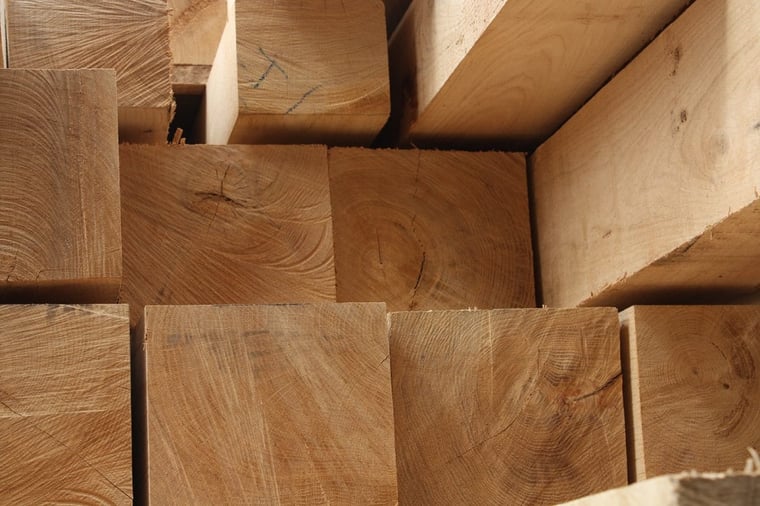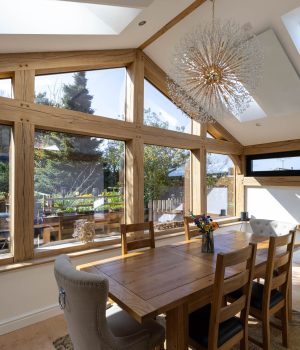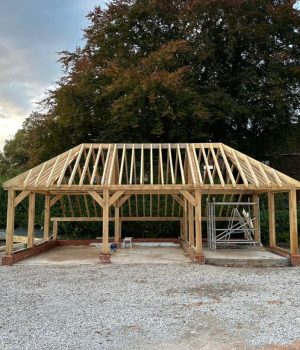.
When it comes to choosing materials for a sustainable, characterful home, oak is a top contender. But if you’ve ever noticed black stains on freshly cut oak or experienced staining on walls or floors near your oak frame, you’ve already encountered one of oak’s most distinctive natural features: tannins.
In this blog, we’ll take a closer look at what tannins are, how they affect oak, and how to work with them—rather than against them—in your building project.
What are Tannins?
Tannins are naturally occurring compounds found in many plants and trees, particularly in oak trees, tea leaves, and some fruits. In oak, they serve as a defence mechanism, protecting the tree against fungi, insects, and bacteria. These compounds are especially concentrated in heartwood—the dense, inner part of the trunk that gives oak its strength and durability.
Oak’s high tannin content contributes to its legendary resistance to decay, making it a favourite for everything from wine barrels to green oak framing. But those same tannins can cause a few quirks worth understanding when you’re building with oak.
How Do Tannins Affect Buildings?
1. Reaction with Water
When oak is exposed to rain or high humidity, tannins can leach out of the timber. This often leads to dark brown streaks or run-off stains, particularly on nearby stone, render, or brickwork.
This leaching is completely natural and typically stops once the oak has had time to season and dry. However, if left unmanaged, tannin stains can be difficult to remove and may impact the appearance of lighter finishes or cladding.
2. Reaction with Iron
Oak tannins are famously reactive with iron. When tannins meet even trace amounts of iron—like nails, screws, or tools—they create a chemical reaction that produces deep blue-black stains.
This is why experienced oak framers always use stainless steel or non-ferrous fixings and tools when working with green oak.
Tips for Managing Tannins in Your Project
✔ Use Stainless Steel or Galvanised Fixings
Avoid any ferrous metals (like mild steel) in contact with oak. Use stainless steel screws, nails, and brackets wherever possible.
✔ Protect Adjacent Surfaces
When oak is freshly cut or newly installed, protect nearby materials—such as pale stonework or white render—from tannin run-off using temporary coverings or drip detailing in the design.
✔ Consider Pre-Treatment
Some builders apply tannin-blocking primers or sealers to oak components before exposure to moisture. Be cautious though: not all finishes allow oak to breathe, which is vital when working with green oak.
✔ Expect and Embrace Character
Tannin marks and run-off are part of oak’s natural behaviour, especially in the early months. Many self-builders and architects embrace these marks as part of the unique, evolving story of the building.
Can Tannin Stains Be Removed?
Yes! For tannin marks on masonry, oxalic acid (a naturally occurring organic acid) can be used carefully to bleach stains. Always test on a small area first, wear protection, and follow safety instructions.
Some people also use professional stone or timber cleaners, but prevention is usually easier than cure.
Tannins are a vital part of what makes oak such a resilient, characterful material. While they can surprise the unprepared, understanding how they behave allows you to build with confidence—and appreciate the natural beauty and integrity of your oak frame.
Whether you’re designing a green oak frame extension or planning a full eco-home, factoring in tannin behaviour is just one more step in creating a timeless, low-impact space that ages with grace.
Looking for more guidance on building with oak?
Check out our other blogs or get in touch with our team for advice on timber selection, finishes, and detailing.




